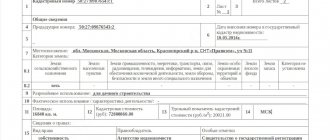Division of land in case of shared ownership
The land fund in the Russian Federation is distinguished as a special type of property and is regulated by many legal acts, for example, the Civil and Land Codes (Civil Code of the Russian Federation and Land Code of the Russian Federation). Art. 252, 254 of the Civil Code of the Russian Federation establishes the right for owners to divide the land plots they own. According to the provisions of Art. 11.4 of the Land Code of the Russian Federation, division of land is also possible.
The main feature of shared ownership is that the owners cannot dispose of the property independently of each other. Since this form of use complicates the exploitation of the land, the owners decide to divide it. As a result of the procedure, new objects with different cadastral numbers appear (find out why a cadastral number is needed).
Agreement requirements
Before executing an agreement, the parties need to verify each other’s legal capacity. In addition, it is important to remember that it is prohibited to reduce the share owned by an incapacitated or minor owner. Even if their interests are represented by legal representatives.
The law does not specify the exact form for the agreement. However, it is subject to the general requirements for contracts.
The document must include the following items:
- Name;
- place of registration;
- date of conclusion;
- details of the parties, including gender, passport details and address;
- information about the land plot (cadastral number, address, total area, data of all owners);
- details of title documents;
- details of the extract from the Unified State Register;
- reasons for changes in the size of shares;
- compensation/free transfer of rights;
- new share options;
- a note indicating that there is no encumbrance on the rights of one of the share owners;
- rights and obligations of the parties;
- number of copies;
- signatures of co-owners.
Important! The absence in the agreement of data on the possibility of challenging the contract in court is not a prohibition on going to court. Either party has the right to protect its property interests in the event of a violation of rights, regardless of the terms of the contract.
The concept of divisibility
A common piece of real estate is considered divisible if it can be broken up into several land plots without deteriorating its performance and violating the property rights of all co-owners, as well as third parties. As a result of this procedure, the land use category should not change.
Also, as a result of the procedure, plots should appear whose area is not less than the minimum permitted value. It is determined individually for each region, but the formation of plots of one or two hundred square meters is unacceptable. Article 11.9 of the Land Code of the Russian Federation regulates the requirements for areas arising in the process of division. For example, in the Moscow region, parameters have been set for:
- farms – 20,000 sq. m. (minimum);
- gardening - 400 sq. m.;
- gardening and country house construction - 600 sq. m.;
- lands for private household plots and individual housing construction - 600 sq. m.
Information on permissible plot sizes for specific areas is clarified in the municipality and federal urban planning regulations. Before dividing the territory, you should pay the land tax, since failure to pay it may result in refusal to register the transaction.
So, based on this information, the following conclusions can be drawn:
- Memory units that have undergone the division process must be checked for compliance with the established minimum and maximum areas. If the land plots formed after division do not meet this requirement, then in the process of registering such land plots for cadastral registration, a legal refusal may follow. This nuance is disclosed in paragraph 3 of Art. 27 No. 218-FZ.
- The allocation of smaller land plots should not lead to problems associated with the operation of capital buildings located on them, as well as with the use of land for its intended purpose. The plot on which the house is built is indivisible if this violates the existing rules and regulations in the area of land use.
- The boundaries of the received plots should not intersect with the boundaries of the forest park zone, forest districts, settlements, and municipalities. Also, interstriated, broken, or wedged types of boundaries are not allowed (read how to determine the boundaries of a land plot).
- It is necessary that all new land plots retain the same type of land use permitted for the old site.
Reasons for refusal of the agreement
The grounds for refusal to redistribute an allotment of municipal land, as well as state and privately owned land, are listed in Art. 39.29 of the Land Code of the Russian Federation , in particular, they boil down to the following:
- The site belongs to the category of lands in respect of which redistribution is prohibited;
- Allotments vary in their intended purpose;
- Land plots are not contiguous;
- Written consent has not been obtained if the sites are burdened with the rights of third parties;
- On the land plot that will be formed as a result of the redistribution, there will be real estate objects related to state, municipal or citizen property;
- The land surveying project includes land that has been withdrawn from civil circulation or limited in it;
- Land holdings belong to various municipalities;
- The land was previously reserved for state or municipal needs;
- The site is the subject of an auction, the holding of which has been duly notified;
- If, after the redistribution, the new plot exceeds the maximum permissible value;
- It is necessary to clarify the boundaries of the plot owned by a private landowner;
- The allotment layout does not correspond to the layout of the territory and land management documents.
Keep in mind! The received refusal to redistribute land territory must be justified, indicating the reason for the prohibition of this procedure.
Thus, the territory can be redistributed between neighbors to change the cadastral plan if they have disagreements regarding the boundaries of adjacent plots, as well as in a legal way to increase ownership at the expense of state or municipal land. A significant advantage of such additions is their cost, which represents a small percentage of the cadastral price of the land.
Indivisible plots
A plot is considered indivisible if:
- there is a building on it (a residential building or a summer house) that cannot be crushed;
- when fragmenting a plot to one of the resulting objects, it is impossible to ensure full passage and passage (a state ban will be established even with the consent of all co-owners, for reasons of fire safety);
- it is recognized as collateral or seized property;
- during division, geometrically uneven, curved and pointed areas are formed;
- after the procedure, targeted and rational land use will deteriorate.
If a plot is officially recognized as indivisible, but the owners want to stop using it jointly, there are several ways out of this situation.
One of the owners can become the owner, and the others will receive monetary compensation in accordance with their shares in the property. To do this, you will need to evaluate the site from an independent expert, based on cadastral and market values. The plot can also be sold and the money received transferred to co-owners.
If both owners do not want to leave the territory, they can determine the procedure for using the site. If you fail to sign a settlement, you will have to go to court with a claim.
Required documents
The final action will be to contact the MFC or Rosreestr to register an agreement on the redistribution of shares in common law. In order for the registrar to accept your application, you need to submit copies of documents.
List of documents:
- 3 copies of the agreement on changes in shared ownership of the house/land;
- passports of shareholders;
- power of attorney + copy of the representative’s passport – if the transaction is entrusted to a third party;
- document of title – includes information about the registration of shared ownership + information about the emergence of such a right (for example, data on a certificate of inheritance);
- other documents - for example, consent of the guardianship authority, parental permission, documents on benefits.
Originals or originals of documents may also be required. Prepare a folder with documentation - it will be useful both when contacting a notary and during your visit to the MFC or Rosreestr.
Methods for dividing a plot
If the co-owners were able to agree peacefully, then they enter into a certain agreement. Moreover, it does not really matter whether the object is divided in accordance with the existing shares or not. If the plots obtained as a result of the procedure comply with generally accepted standards, then unequal division of property will not be a reason for refusing to register the transaction if all participants agree to conclude it.
If at least one of the shareholders does not agree with the proposed solution, or the whereabouts of one of the owners is unknown, the need arises to resolve the dispute in court. Depending on the technical characteristics, the court may decide:
- on the allocation of plots to all co-owners;
- on the procedure for using land if the object is recognized as indivisible;
- on the sale of a plot (find out how to draw up a contract for the sale and purchase of a land plot).
Even after a court decision is made, there is a small percentage that one of the owners will not agree with the court's conclusions, in which case he can file an appeal.
Plot division agreement
This document is drawn up by the co-owners independently and voluntarily. There is a legally approved form for this legal document. It is better to have the agreement certified by a notary, and only then take it to the local municipality for confirmation. When registering, the consent of all co-owners is required, otherwise the transaction will not be registered.
The document must contain:
- key terms as agreed;
- details of the parties;
- detailed description of the site for unambiguous identification (area, cadastral number, category of permitted land use, etc.);
- procedure for incurring expenses;
- date and place of signing;
- Sample signatures of owners.
But the full list of important points depends on the specifics of the transaction ().
Resolving situations with indivisible plots
First of all, if a situation arises during which it becomes necessary to carry out the divorce process, it is necessary to establish the fact of divisibility and indivisibility of jointly acquired property, since not all real estate objects are subject to mandatory alienation. The property cannot be divided if it belongs only to the husband or wife, if it:
- was the individual property of one of the spouses before the wedding (Article 36 of the RF IC);
- purchased with the personal funds of the husband or wife (Article 34 of the RF IC);
- was given (or inherited) to one of them.
If the second spouse does not prove that the land acquired with the funds of the other was improved with common funds during the marriage, and therefore increased in price, then he has no right to claim it.
Capital and non-permanent buildings on the territory
If there is a house on the territory, then conclusions about the divisibility of the plot are largely based on whether the building itself can be divided. Parts of a building can be isolated if:
- each half of the house has its own exit to the street;
- each part of the building has a separate electrical panel and an autonomous power supply and heating system;
- the building has several window openings for natural lighting of the room and utility rooms;
- the entire building and its separate parts comply with sanitary standards.
If the house cannot be divided in kind, the owners usually draw up an agreement that one of them becomes the owner of the building, and the rest receive monetary compensation. Even in the case of construction of an object within the framework of shared construction, its actual division is impossible without carrying out appropriate technical expertise.
If a building is divided into a plot, the building is first divided, and only then each owner is allocated the most suitable part of the territory.
Arbitrage practice
There are cases when spouses do not come to a common decision. In such situations, they go to court.
It takes a lot of time to prepare the necessary documents and initiate legal proceedings; in some cases, it happens that by the time the case of division of property is considered by the court, some part of the jointly acquired property is sold or donated by an unscrupulous spouse. In such cases, the requirements for division are supplemented with the requirement to invalidate the transaction for the alienation of the plot or part thereof.
When necessary
Redistribution of land plots is carried out in the following cases:
- If necessary, lay communications along the neighboring site;
- To maintain the minimum permissible distance from the house to the border of the plot;
- If the boundaries of neighboring plots are changed by a court decision;
- If it is necessary to divide one plot between several owners;
- To increase the area of one plot at the expense of the neighboring one;
- To eliminate broken boundaries of allotments or stripes;
- For the construction of housing on the border of adjacent plots belonging to the same owner.
If part of the communications (water supply, electricity), due to the peculiarities of engineering calculations, must be laid on a neighboring plot, then it is advisable to redistribute the boundaries by purchasing part of the neighboring plot where these communications will be located.
It is important to remember that the distance from a residential building to the border of the plot of land must be at least three meters, and if construction has already begun too close to the borders, it makes sense to move them .
Dividing a plot of land into separate plots may be necessary when registering an inheritance right to such a plot by several heirs who want to continue using the land, as well as when dissolving a peasant-farmer shareholding, when each participant is entitled to an allocation of a land share in kind.
If the boundaries of a site are broken or have sharp corners, as well as in the case of uneven delimitation with alternating inclusions of someone else’s property (interstriped), then such a site is often inconvenient to use, and redistribution will help form more even boundaries.
Redistribution is also necessary when the owner wants to increase the area of his plot by annexing undivided municipal land (addition), or by merging two of his own neighboring plots, eliminating their adjacent border.
Division of a plot with one owner
If a person owns a plot of land individually, he also has every right to divide it in kind into two or more parts, if the procedure results in plots that meet general legal requirements and urban planning regulations.
Possible reasons
A sole owner may decide to subdivide the territory for the following reasons:
- he decided to rent out or donate one of the parts;
- the owner is selling the plot, and it can be sold in parts much more profitably and quickly, since the main pool of buyers are looking for small plots;
- the owner decided to start a business, and for this it is necessary to change the land category (for example, replacing the category of individual housing construction with agricultural land).
Solution
If the plot belongs to one owner, then the main document on the basis of which the procedure will be carried out will be the decision of the property owner to divide the plot. It should contain the following information:
- owner details;
- a complete description of the divided area with detailed technical characteristics;
- basis of ownership with documentary evidence;
- data on the resulting plots.
Completion of this document is necessary, since it will be the basis for the division of land in the registration authorities.
Procedure and order of redistribution
The procedure for land redistribution invariably begins with a visit to an authorized organization, for example a city administration, which has the right to accept applications for land redistribution. In the statement, according to Art.
. 32.29 of the Land Code of the Russian Federation, the following information is indicated:
- Applicant’s passport details and contact details;
- Name, location of the legal entity, its registration data, if it is a participant in the redistribution;
- Cadastral information of adjacent land plots;
- Details of the land surveying project.
The main stages of dividing a land plot
The standard procedure for the legal and actual division of an allotment consists of several stages, characteristic of all types of ownership (shared and individual).
Surveying
A mandatory step when dividing a plot. It is necessary to verify the actual boundaries of the plots. Land surveying must be carried out by a professional cadastral engineer with the appropriate certificate.
Read more about what land surveying is and why it is needed.
Land surveying can take place desk-based or with a specialist visiting. In the first case, the owners themselves draw the proposed boundary on the old plot plan. Then the division of the site is carried out on the basis of area characteristics, and the actual division of the territory is carried out after receiving cadastral numbers. Only then does a cadastral engineer come to the site and place land boundary markers based on registration data. This method is convenient if you do not need to accurately determine the configuration of the site and boundaries on the ground.
Otherwise, it is better to initially invite a cadastral engineer to measure the divided territory. Then the specialist carries out technical measurements on the ground, checking them with theoretical data, and then prepares a boundary plan for the location of new plots of land, their shape and area.
This process must take place in the presence of all co-owners of the property or their representatives, so that it is possible to divide the territory according to actual use, for example, based on installed fences and other barriers. The approved completed boundary plan is temporarily placed in electronic storage.
Address assignment
After completing the land surveying procedure, you should contact the municipality to obtain the addresses of new objects. The assignment procedure lasts no more than 18 days, after which the applicants are given a corresponding decision.
Cadastral registration and registration
The Land Code provides for the simultaneous deregistration of a large plot of land and the registration of the resulting real estate objects. This procedure is carried out by Rosreestr. You can submit documents to one of the branches of the registration authority, but it is much more convenient to do this through the MFC or the government services website. The cost of the state fee will not change in any way depending on the application submission option and will be:
- 350 rub. for each newly formed plot of individual housing construction and private plots;
- 350 rub. for lands of all other categories.
Registration of the transaction takes place within 10 – 12 working days. After this period, new land plots appear, information about which is confirmed by an extract from the Unified State Register of Real Estate.
Required documents
When registering the division of an allotment, a complete documentation set is submitted:
- passports of all participants in the transaction;
- application (the form can be downloaded in advance on the Internet);
- title documents for land;
- decision on assigning addresses to new real estate objects;
- a division agreement, a single owner's decision, or a court order;
- boundary plan or its identification number in electronic storage;
- confirmation of payment of state duty (documentary or electronic format);
- power of attorney, if one of the co-owners acts through a representative (a sample is taken from a notary).
Taxation nuances
The moment of emergence of ownership of new plots will be the date of state registration of a large plot. Therefore, all legal issues related to taxation when selling and donating real estate are calculated based on the date in the first certificate.
Documentation
The execution of the agreement can be entrusted to a notary. However, the parties must first obtain legal advice about the consequences of the decision. The person whose share is being reduced must be aware that he is transferring part of the property to a co-owner.
Also, the parties can independently prepare the project, and the notary will only formalize it in the proper form. Starting from 2021, the obligation to transfer the agreement for state registration to Rosreestr rests with the notary (if the transaction was subject to notarization).
To formalize the agreement, the parties must provide the following documentation:
- civil passports of the parties;
- birth certificate of the minor owner;
- extract from the Unified State Register of Real Estate;
- information about the absence of encumbrances;
- title documents;
- power of attorney and passport of the representative (if available);
- home appraisal report;
- certificate of cadastral value of the land plot;
- consent of the spouses (if the object was purchased during marriage).










